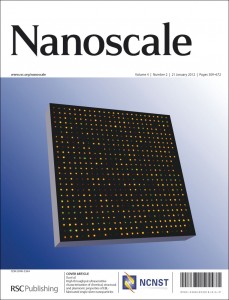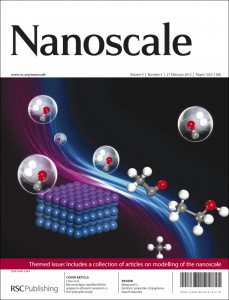 Nanoscale is delighted to announce that Andrea Ferrari, Xiaogang Liu and Hongxing Xu have joined our Editorial Board.
Nanoscale is delighted to announce that Andrea Ferrari, Xiaogang Liu and Hongxing Xu have joined our Editorial Board.
All three along with co-Editor-in-chief Wei Lu are experts in the field of nanoscale devices, and they have picked some of their favourite articles recently published in this field in Nanoscale.
Read these exciting devices articles for free for a limited period:
Reviews:
Tin and germanium monochalcogenide IV–VI semiconductor nanocrystals for use in solar cells
Priscilla D. Antunez, Jannise J. Buckley and Richard L. Brutchey
DOI: 10.1039/C1NR10084J
Structure sensitivity and nanoscale effects in electrocatalysis
Marc T. M. Koper
DOI: 10.1039/C0NR00857E
Solution-phase synthesis of metal and/or semiconductor homojunction/heterojunction nanomaterials
Xiumei Feng, Guanqi Hu and Jianqiang Hu
DOI: 10.1039/C1NR00004G
Graphene edges: a review of their fabrication and characterization
Xiaoting Jia, Jessica Campos-Delgado, Mauricio Terrones, Vincent Meunier and Mildred S. Dresselhaus
DOI: 10.1039/C0NR00600A
Original research:
Simultaneous synthesis and functionalization of water-soluble up-conversion nanoparticles for in-vitro cell and nude mouse imaging
Zhen-Ling Wang, Jianhua Hao, Helen L. W. Chan, Ga-Lai Law, Wing-Tak Wong, Ka-Leung Wong, Margaret B. Murphy, T. Su, Z. H. Zhang and S. Q. Zeng
DOI: 10.1039/C1NR10090D
Site-selective localization of analytes on gold nanorod surface for investigating field enhancement distribution in surface-enhanced Raman scattering
Tao Chen, Chaoling Du, Li Huey Tan, Zexiang Shen and Hongyu Chen
DOI: 10.1039/C0NR00845A
Striped nanowires and nanorods from mixed SAMS
Chetana Singh, Ying Hu, Bishnu P. Khanal, Eugene R. Zubarev, Francesco Stellacci and Sharon C. Glotzer
DOI: 10.1039/C1NR10215J
Scanning Near-Field Ellipsometry Microscopy: imaging nanomaterials with resolution below the diffraction limit
Davide Tranchida, Jordi Diaz, Peter Schön, Holger Schönherr and G. Julius Vancso
DOI: 10.1039/C0NR00530D
From stochastic single atomic switch to nanoscale resistive memory device
Attila Geresdi, András Halbritter, András Gyenis, Péter Makk and György Mihály
DOI: 10.1039/C0NR00951B
Conductive indium-tin oxide nanowire and nanotube arrays made by electrochemically assisted deposition in template membranes: switching between wire and tube growth modes by surface chemical modification of the template
Nina I. Kovtyukhova and Thomas E. Mallouk
DOI: 10.1039/C0NR00789G
Large area flexible SERS active substrates using engineered nanostructures
Aram J. Chung, Yun Suk Huh and David Erickson
DOI: 10.1039/C1NR10265F
Multicolored nanometre-resolution mapping of single protein–ligand binding complexes using far-field photostable optical nanoscopy (PHOTON)
Tao Huang and Xiao-Hong Nancy Xu
DOI: 10.1039/C1NR10182J
Nano-optical information storage induced by the nonlinear saturable absorption effect
Jingsong Wei, Shuang Liu, Yongyou Geng, Yang Wang, Xiaoyi Li, Yiqun Wu and Aihuan Dun
DOI: 10.1039/C1NR10395D
Facile production of up-converted quantum dot lasers
Raffaella Signorini, Ilaria Fortunati, Francesco Todescato, Samuele Gardin, Renato Bozio, Jacek J. Jasieniak, Alessandro Martucci, Gioia Della Giustina, Giovanna Brusatin and Massimo Guglielmi
DOI: 10.1039/C1NR10801H
Nonvolatile resistive switching in single crystalline ZnO nanowires
Yuchao Yang, Xiaoxian Zhang, Min Gao, Fei Zeng, Weiya Zhou, Sishen Xie and Feng Pan
DOI: 10.1039/C1NR10096C
Structure and photoelectrochemistry of a virus capsid–TiO2 nanocomposite
Craig Jolley, Michael Klem, Richard Harrington, John Parise and Trevor Douglas
DOI: 10.1039/C0NR00378F
Device and SPICE modeling of RRAM devices
Patrick Sheridan, Kuk-Hwan Kim, Siddharth Gaba, Ting Chang, Lin Chen and Wei Lu
DOI: 10.1039/C1NR10557D
















 Read this highly topical feature review article today:
Read this highly topical feature review article today: